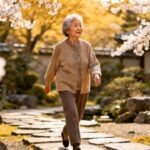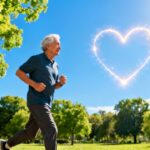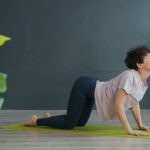What if the secret to walking without pain, standing without fear, and living with more strength and freedom wasn’t surgery or expensive supplements, but a small, often overlooked part of your thigh?
The vastus medialis oblique (VMO) – that tiny muscle on the inside of your quadriceps – could be the game changer you’ve been waiting for if your knees have ever felt unstable, stiff, or achy.
Why Your VMO Matters After 50
When you’ve had years of knee pain, arthritis, swelling, or even just a sedentary lifestyle, your brain starts to disconnect from the muscles that protect your joints, especially the VMO.
This small muscle acts like a steering wheel for your kneecap, and when it doesn’t activate properly, other muscles take over, pulling the kneecap out of alignment and causing pain.
VMO Exercise 1: Active Foam Rolling
Before we strengthen the muscle, we need to wake it up. This isn’t your typical roll-and-hope-for-the-best approach – it’s intentional, dynamic, and neurologically smart.
By applying pressure to your quadriceps while actively bending your knee, you’re telling your brain, “Hey, this muscle matters again.”
How to do it:
- Lie face down with a foam roller just above your knee.
- Slowly bend your knee as you roll your thigh toward your hip.
- Each bend activates the hamstrings while releasing tension in the quad.
- If you feel a tight or tender spot, pause, breathe, and let the muscle melt.
- Roll for one to two minutes per leg.
- Do it daily for two weeks, then reduce to two to three times a week.
VMO Exercise 2: Prone Chain Activation
If your knees are hurting, your VMO isn’t the only muscle that’s gone quiet. Pain has a way of turning down the volume on the entire support system.
This exercise gets the whole team back online, especially the often neglected muscles behind and beneath your knees.
How to do it:
- Lie face down with legs straight.
- Activate your glutes first, then fully straighten one knee into terminal extension.
- Flex the ankle, toes towards shin, and hold everything tight for 30 seconds.
- Keep shoulders, neck, and jaw relaxed. Repeat three times each side, alternating left and right.
VMO Exercise 3: VMO Precision Drill
This drill teaches your VMO to fire first, just as nature intended. The key here is isolation and intention – you’re not just moving your leg; you’re activating the VMO first, then letting the movement follow.
How to do it:
- Sit or lie down with your leg extended.
- Gently tighten the VMO just above the inside of your kneecap.
- Keep it activated as you slowly straighten your knee.
- Once fully extended, point your toes downward (plantar flex) and hold for 10 seconds.
- Then flex your ankle upward (dorsiflex) and hold for 10 seconds.
- Keep the VMO engaged throughout. Repeat three to five times per leg.
VMO Exercise 4: Functional Lunge with VMO Focus
Now it’s time to bridge the gap between exercise and everyday life. This final exercise teaches your body to use the VMO where it matters most: in upright, load-bearing movement.
How to do it:
- Begin in a split stance, one foot forward.
- Press into the front foot, especially the ball (metatarsals), to engage your foot arch.
- Lightly touch your VMO with your hand to feel it turn on.
- Slowly rise to standing using that front leg.
- Hold the top position for five seconds, balancing tall and stable.
- Slowly return to start. Repeat four to six reps per leg.
Reclaim Your Mobility and Confidence
What you’ve done with these exercises isn’t just about your knees; it’s about reclaiming agency over your health. You’ve reconnected with muscles that may have been silent for years, and in doing so, you’ve reawakened possibility.
Remember, pain is not a sentence; it’s a signal. And when you respond with movement, awareness, and intention, healing begins.
By activating your VMO, restoring muscle balance, and integrating strength into functional movement, you’re not just supporting your joints; you’re giving your future self a gift: the freedom to move with confidence.
Whether you’re walking your dog, playing with your grandkids, or simply standing up without hesitation, every bit of strength and stability matters.








